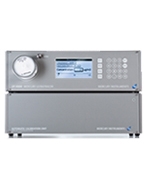
- - MicrotracBEL
- - Grabner
- - Iludest
- - AD Systems
- - Porometer
- - Fueltech
- - Orbis
- - Hydramotion
- - Gibertini
- - Mercury Instrument
- - Paragon Scientific
- - Rubolab
- - Normalab
- - Green Lab
- - Tanaka
- - Forza International
- - Carbolite Gero
- - Adscientis
- - 흡착 (adsorption)
- - 석유화학 (petrochemical)
- - 열중량분석 (TG)
- - 멤브레인 (membrane)
- - 증류 (distillation)
- - 점도 (viscosity)
- - 와인학 (oenology)
- - 실험실 (lab instrument)
- - 촉매특성평가 (TPD/TPR)
- - 연료전지성능평가(Fuel cell)
- - 반응기(Micro-Reactor)
- - 가스분석기(Mass spectrometer)
- - 수은분석 (mercury)
- - 표준시약 (CRM, SRM)
 |
Mercury Ultratracer UT 3000 |
Measuring of Total Gaseous Mercury (TGM) in Air and other Gases at Ultra Trace Levels |
|
| Features | |
|
##Air quality studies ##Monitoring of indoor air pollution ##Environmental pollution source tracking ##Plume profiling ##Studies of mercury dispersion in the atmosphere ##Studies of interaction between atmosphere and surfaces ##Pollution prevention ##Natural gas and derivatives ##Soil and ground degassing studies
Measurement of Total Gaseous Mercury in Air or Other Gases at Ultratrace LevelsThe UT-3000 Mercury UltraTracer provides a compact and reliable tool for measuring mercury in gases at ultra trace levels. Utilizing the high performance GoldTrap amalgamation module and an optimized state-of-the-art AA-mercury vapor detector the UT-3000 UltraTracer offers detection limits at sub-ng/m³ (ppq-parts per quadrillion) levels.
Measuring principleThe sample gas is fed into an optical cell by a maintenance-free membrane pump. A beam of UV light passes through the optical cell, a part of it is absorbed by the mercury atoms present in the sample. This method is called "atomic absorption spectroscopy" or shortly AAS. It is extremely selective and sensitive. For mercury determination the AAS method has maintained its importance even if other methods have been worked out since the early beginnings. The AAS method is low in interference and does not require an amalgamation step or expensive carrier gases.
Automatic OperationThe UT-3000 operates automatically. All functions are controlled by an embedded microprocessor. Once the analysis has been started, measurements are performed and data is collected by the built-in data logger. With standard settings the data logger has a recording capacity of 4 weeks.
GoldTrap Amalgamation SystemFor use in the UT-3000 a new trapping system has been developed: the Mercury GoldTrap, which is one of the key components of the system. It consists of a wafer thin ceramic tube which has been carefully crafted to achieve minimum thermal inertia. The tube has been packed with ultrapure gold and supports a heating coil on its outside. The Mercury GoldTrap reveals sharp and high peaks and an excellent long-term stability. As air is used for purging the trap during the heating step, possible contaminations are oxidized and swept off thus preventing from passivation. It is essential that the trap is free of mercury before sampling. This is ensured by an automatic cleaning step prior to the sampling.
Sample Flow ControlThe sample flow is measured with a high precision electronic mass flow meter. The flow rate integrated over time gives the total sample volume. The flow is automatically changed to a lower value during the desorption step to achieve maximum sensitivity.
How does the UT-3000 work?Mercury Instruments UT-3000: Flow diagram The Mercury Instruments GoldTrap is used to capture total gaseous mercury (TGM) directly from the atmosphere. GoldTraps work because mercury sticks to gold at room temperature. A gas carrying gaseous mercury is pulled through the trap; the gas continues to flow through the trap but the mercury stays behind--trapped on the gold. After the mercury is captured, the GoldTrap is heated very quickly; this releases the mercury as a gas (thermal desorption). The gaseous mercury is then swept by the flow of purified mercury free air into the optical cell of the detector. Here the mercury is measured by atomic absorption spectrometry.
Atomic Absorption DetectorThe detector used in the UT-3000 provides a maximum of sensitivity, precision and stability. A high frequency driven electrodeless mercury low pressure lamp is used as UV light source. It generates a 253.7 nm emission line of an extremely narrow bandwidth which is congruent with the absorption line of the Hg atoms measured. The reference beam method is applied to get an exceedingly high stability of the UV source. The mercury concentration is measured in an optical cell which has been made entirely of fused silica (Suprasil). Thanks to the sensitivity enhancement provided by the GoldTrap there is no need for a long path cell which always has a greater surface effect. Solid state UV detectors are used for absorption measurement.
CalibrationThere are two methods to check and calibrate the instrument: One way is to capture mercury on the GoldTrap by bubbling air through a liquid mercury standard to which stannous chloride solution has been added. Another quick, accurate, and precise way is the static calibration with mercury saturated air. Gaseous mercury is injected directly onto the GoldTrap. In this case the built-in calibration port is used which is internally connected to the sample gas line leading into the GoldTrap. The calibration port is equipped with a septum through which gaseous mercury is injected with a syringe. The type of syringe used for this purpose is specially designed to measure and dispense gases. The mercury is then automatically drawn onto the GoldTrap. Calibration gas sources are available as accessories. The calibration check procedure can be automatized as an option.
Display and Output of MeasurementsThe results of the measurements are displayed on a graphic LCD as a graph and numerically. It is possible to view past readings with a paging function. Calibrations are stored in a non-volatile memory. The device has a serial interface for data transfer to a PC and a 0-20 mA output.
Advantages of the AA Detection MethodThe latest AA detection technique used in the UT-3000 offers some clear advantages over other methods. Mercury trace detection by fluorescence must use a carrier and sometimes a sheath gas and suffers from the quenching effect which can never be completely eliminated. The UT-3000 requires no expensive gases for operation and there are no negative interferences caused by the quenching effect. Sensitivity and detection limits are far superior to those instruments based on measurement of electrical resistivity of a thin gold film.
Mercury Monitoring in Natural Gas and LNGMercury is a frequent constituent of natural gas. It can be found in concentrations ranging from a few µg/m³ to more than10000 µg/m³. An important application for the UT-3000 is the measurement of mercury in natural gas and liquefied natural gas (LNG). A special version of the UT-3000 analyser is dedicated for measurement of mercury in natural gas. Both a manual system using the Tedlar® Bag Technique as well as an automatic system for on-line installations are available. |
|







